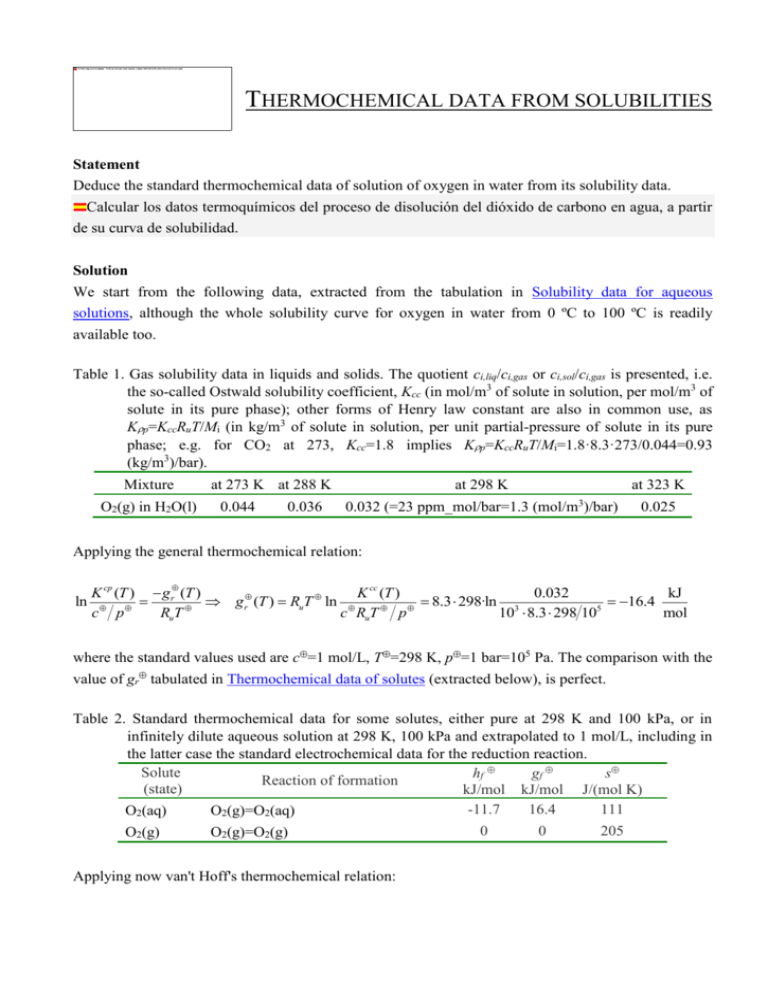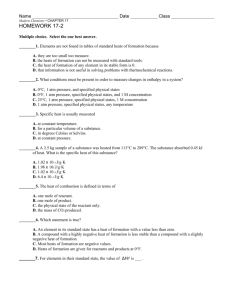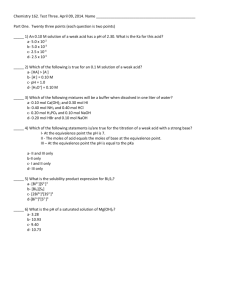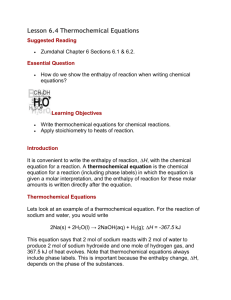Exercise2 - Portal del DMT
advertisement

THERMOCHEMICAL DATA FROM SOLUBILITIES Statement Deduce the standard thermochemical data of solution of oxygen in water from its solubility data. Calcular los datos termoquímicos del proceso de disolución del dióxido de carbono en agua, a partir de su curva de solubilidad. Solution We start from the following data, extracted from the tabulation in Solubility data for aqueous solutions, although the whole solubility curve for oxygen in water from 0 ºC to 100 ºC is readily available too. Table 1. Gas solubility data in liquids and solids. The quotient ci,liq/ci,gas or ci,sol/ci,gas is presented, i.e. the so-called Ostwald solubility coefficient, Kcc (in mol/m3 of solute in solution, per mol/m3 of solute in its pure phase); other forms of Henry law constant are also in common use, as Kp=KccRuT/Mi (in kg/m3 of solute in solution, per unit partial-pressure of solute in its pure phase; e.g. for CO2 at 273, Kcc=1.8 implies Kp=KccRuT/Mi=1.8·8.3·273/0.044=0.93 (kg/m3)/bar). Mixture O2(g) in H2O(l) at 273 K at 288 K 0.044 0.036 at 298 K at 323 K 0.032 (=23 ppm_mol/bar=1.3 (mol/m3)/bar) 0.025 Applying the general thermochemical relation: ln K cp (T ) g r (T ) K cc (T ) 0.032 kJ g ( T ) R T ln 8.3 298·ln 3 16.4 r u 5 c p RuT c RuT p 10 8.3 298 10 mol where the standard values used are c=1 mol/L, T=298 K, p=1 bar=105 Pa. The comparison with the value of gr tabulated in Thermochemical data of solutes (extracted below), is perfect. Table 2. Standard thermochemical data for some solutes, either pure at 298 K and 100 kPa, or in infinitely dilute aqueous solution at 298 K, 100 kPa and extrapolated to 1 mol/L, including in the latter case the standard electrochemical data for the reduction reaction. Solute hf gf s Reaction of formation (state) kJ/mol kJ/mol J/(mol K) -11.7 16.4 111 O2(aq) O2(g)=O2(aq) 0 0 205 O2(g) O2(g)=O2(g) Applying now van't Hoff's thermochemical relation: d ln K cc K 2cc K cp 0.025 d ln ln ln cc c R T p K c p hr 0.053 11.0 kJ u 1 hr Ru Ru 8.3 1 1 1 1 1 1 Ru mol d d T T T2 T1 323 273 which compares not too bad with the hr value in Thermochemical data of solutes (11.0 against 11.7 kJ/mol), perhaps due to the discretization on the slope (we had computed the mean slope at 273 K and 323 K instead of the slope at the middle; a better curve-fitting gives hr=11.6 kJ/mol, perfectly correcting the mismatch). We can check for consistency in the tabulated Thermochemical data of solutes by means of the general equation: O2 ( g ) O2 ( aq ) g r hr T sr hr g r T saq sgas 16400 298 111 205 11.6 i.e. all tabulated data are coherent (11.6 against 11.7). Comments A graph of solubilities for several gases: Fig. 1. Solubility curves for some gases in water at 100 kPa. Back kJ mol K









